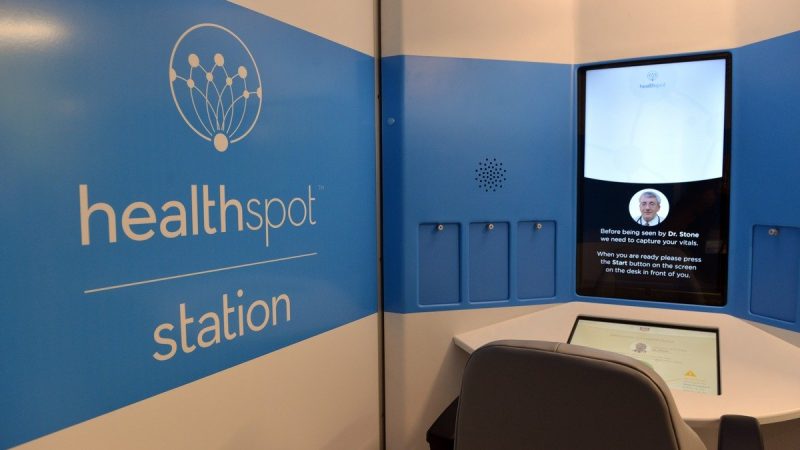The healthcare industry is undergoing a massive digital transformation, and at the center of this change are solutions like HealthSpot. Designed to improve patient access, affordability, and convenience, HealthSpot combines technology and healthcare delivery into one accessible system.
Whether through kiosks in retail stores, virtual visits, or community-based health hubs, HealthSpot and similar platforms are shaping the way patients interact with doctors and manage their health. In this article, we’ll explore the concept, benefits, history, and impact of HealthSpot, as well as its role in the future of telemedicine.
What Is HealthSpot?
HealthSpot was originally known for its telehealth kiosks, which provided patients with a private, technology-enabled booth where they could connect with healthcare providers remotely. The concept was simple but revolutionary:
- Walk into a HealthSpot kiosk (often located in pharmacies or community centers).
- Access medical devices like stethoscopes, thermometers, and blood pressure cuffs.
- Connect via high-definition video with a licensed healthcare provider.
This innovation made it easier for patients to receive care without visiting a traditional clinic or hospital.
Today, the concept of HealthSpot extends to a wider digital health ecosystem—covering telemedicine platforms, digital check-in solutions, and integrated health kiosks.
The Rise of Telehealth and the Role of HealthSpot
Over the past decade, telemedicine has shifted from being a convenience to a necessity. Key drivers include:
- Rising healthcare costs
- Shortages of primary care physicians
- Demand for more accessible care in rural areas
- COVID-19 pandemic, which accelerated adoption of digital health solutions
HealthSpot tapped into this need early by making healthcare accessible in places like grocery stores, retail pharmacies, and workplaces.
Key Features of HealthSpot Kiosks and Platforms
- Remote Consultations
Patients connect with providers via secure video conferencing.
- Integrated Medical Devices
Tools like stethoscopes, otoscopes, and dermatoscopes allow providers to conduct physical assessments remotely.
- Convenient Locations
Kiosks were installed in retail chains, community centers, and even employer campuses.
- Affordable Pricing
Visits typically cost less than urgent care or emergency room alternatives.
- Data Integration
Many systems integrate with electronic health records (EHRs) for seamless patient history tracking.
Benefits of HealthSpot for Patients
Accessibility
Patients in underserved or rural areas gain access to medical professionals without long travel times.
Convenience
No need for long wait times in clinics—appointments can be booked quickly and completed in minutes.
Affordability
Lower costs compared to ER or urgent care visits.
Privacy
Kiosks and digital systems provide private, HIPAA-compliant environments.
Extended Hours
Unlike traditional clinics, kiosks or telehealth solutions may be available evenings and weekends.
Benefits for Healthcare Providers and Systems
- Reduces strain on emergency rooms.
- Expands the patient base without the need for new physical clinics.
- Improves efficiency by reducing no-show appointments.
- Supports preventive care, helping patients manage chronic conditions.
HealthSpot’s Place in the Digital Health Ecosystem
While HealthSpot was a pioneer, other platforms have since expanded the idea, including:
- Teladoc Health
- Amwell
- MDLIVE
- Retail clinics powered by CVS Health and Walgreens
Still, the HealthSpot brand remains synonymous with innovation in healthcare kiosks and telehealth.
HealthSpot and Community Health
HealthSpot technology has been especially impactful in:
- Schools – Helping students access care without missing class.
- Workplaces – Offering employees easy access to medical advice.
- Pharmacies – Pairing medical consultations with prescription fulfillment.
- Rural communities – Filling gaps where clinics and doctors are scarce.
By embedding healthcare into daily life, HealthSpot improves preventive care and early detection.
Potential Challenges and Criticisms
While innovative, HealthSpot and similar solutions face challenges:
- Technology Barriers – Not all patients are comfortable using digital kiosks or apps.
- Limited Scope – Some conditions still require in-person visits.
- Reimbursement Issues – Insurance coverage for telehealth varies.
- Sustainability – Early versions of HealthSpot kiosks struggled with business scalability.
Despite these challenges, digital healthcare continues to expand, showing that the concept is sound and evolving.
The Future of HealthSpot and Digital Healthcare
Looking ahead, platforms like HealthSpot will likely evolve to include:
- AI-driven diagnostics for quicker triage.
- Wearable integration, allowing kiosks and apps to sync with health trackers.
- Expanded mental health services.
- Pharmacy integration for instant prescriptions.
- Home-based kiosks for patients with chronic conditions.
As telemedicine becomes mainstream, HealthSpot’s pioneering model will inspire future innovations.
Tips for Patients Using HealthSpot or Similar Services
- Prepare Medical History – Have medications and allergies on hand.
- Check Coverage – Verify insurance acceptance before visits.
- Use for Appropriate Conditions – Great for minor illnesses, check-ups, and chronic care management.
- Follow-Up – Make sure results are shared with your primary care provider.
- Embrace Preventive Care – Don’t wait for emergencies—use kiosks for screenings and early intervention.
Why HealthSpot Still Matters in 2025
Even if the original kiosk business model faced setbacks, the idea behind HealthSpot—bringing healthcare to people instead of making people chase healthcare—remains vital.
- Retail health clinics are booming.
- Telehealth visits are now part of standard care.
- Community health hubs are improving equity in underserved populations.
HealthSpot’s legacy is clear: it was ahead of its time in rethinking how and where healthcare happens.
Conclusion
HealthSpot represents a turning point in healthcare innovation. From its early telehealth kiosks to its lasting influence on digital health strategies, it paved the way for accessible, affordable, and convenient care.
While the healthcare landscape continues to evolve, the principles behind HealthSpot remain highly relevant:
- Empower patients with choice and convenience.
- Use technology to expand access and affordability.
- Keep healthcare patient-centered and community-focused.
As we move deeper into an era of telemedicine and digital health integration, HealthSpot’s model continues to inspire solutions that make healthcare more efficient, equitable, and accessible for all.
FAQs
1. What was HealthSpot originally known for?
HealthSpot gained recognition for its telehealth kiosks that allowed patients to connect with doctors remotely in retail and community settings.
2. Is HealthSpot still active today?
The original kiosk company faced challenges, but the HealthSpot model lives on through modern telehealth and retail clinic solutions.
3. How is HealthSpot different from regular telehealth apps?
Unlike video-only apps, HealthSpot kiosks included medical devices that allowed doctors to perform remote physical exams.
4. Who benefits most from HealthSpot services?
Patients in rural areas, busy professionals, students, and anyone seeking affordable, accessible healthcare.
5. What’s the future of HealthSpot-like technology?
Expect integration with AI, wearables, and expanded pharmacy services to make healthcare even more seamless.
Also read: Santander Data Breach 2024: What Happened, Who Was Affected, and What You Need to Know









